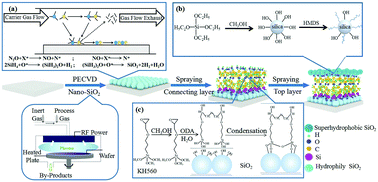Fabrication of transparent, durable and self-cleaning superhydrophobic coatings for solar cells
Abstract
Herein, a superhydrophobic coating with high transparency and ultrahigh adhesive force was designed and prepared for use on the glass covers of solar cells, which exhibited excellent thermal stability and strong acid–base corrosion resistance. SiO2, as the bottom layer, was prepared via plasma enhanced chemical vapor deposition (PECVD), and then glycidoxypropyltrimethoxysilane (KH560) hydrolysis condensation resulted in the formation of hydroxyl groups at the two ends, which were used to form a network structure as the middle connecting layer. The top superhydrophobic layer was obtained via the hydrophilic modification of SiO2 by hexamethyldisilazane (HMDS). The structure of this superhydrophobic surface is similar to the bilayer structure of the phospholipids in the cell membrane. The superhydrophobic coating exhibited high optical transmittance, which reached 94% in the visible region. The results show that the superhydrophobic coating has an excellent self-cleaning performance (WCA = 153°). Moreover, its surface showed remarkable stability against strong acid, strong alkali, and the impact of water drops and sand. Finally, a simple simulation of silicon-based superhydrophobic glass solar cells was carried out, and a long-term outdoor experiment was performed to test their photoelectric conversion efficiency. During the two-month study period, the power conversion efficiency (PCE) of the solar cell module without the coating was reduced to 13.01% due to the natural deposition of dust, which was significantly lower than that of the superhydrophobic coating-covered module with self-cleaning function (PCE was 14.21%).



 Please wait while we load your content...
Please wait while we load your content...